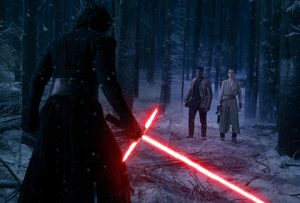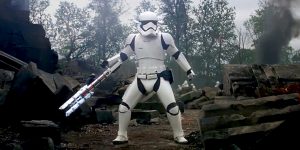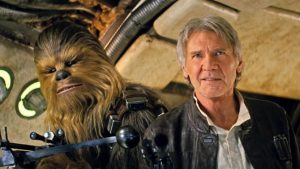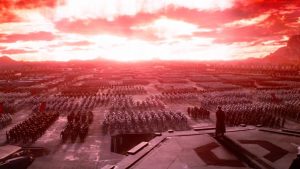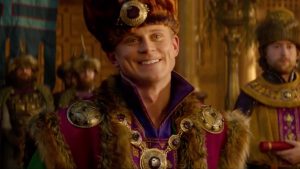Minor SPOILERS For Star Wars: The Rise Of Skywalker Ahead!
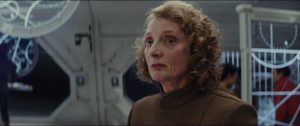
First up, an apology: in my Star Wars: The Rise Of Skywalker Spoiler Review, I made the fictitious claim that a couple depicted kissing near the end of the movie was a lesbian couple. There is, in fact, no clear indication of the sexual orientations of either Commander Larma D’Acy or her partner – they could be lesbian, but there’s also nothing to suggest they aren’t pansexual, bisexual, or a different sexual orientation entirely. And that is part of the problem with Star Wars‘ small, misguided attempt at LGBTQ+ representation.
For years now, but especially since the release of Star Wars: The Force Awakens in 2015, fans of the series have been urging Disney Studios and Lucasfilm to introduce meaningful LGBTQ+ representation into the franchise – emphasis on “meaningful”, as in: an LGBTQ+ character with an established identity, whom audiences actually know and care about. Star Wars has long been near the forefront of the push for diversity in genre fiction, much fellow sci-fi series Star Trek (which, overall, has actually done a better job, though not always with LGBTQ+ representation specifically): even back in the 70’s and 80’s, Star Wars was including women (or rather, two white women) in positions of power and strength, and including dynamic and complex people of color (or rather, one person of color) in the central narrative. The prequel trilogy gave us memorable characters such as Mace Windu, Padmé Amidala, and Jango Fett, while also introducing a number of other problems; the racially insensitive Gungans, the racially insensitive Neimoidians, and the fact that Jango Fett’s army of clones were little more than expendable cannon fodder, among them. The Disney-produced sequel trilogy, on the other hand, started off with a female protagonist, alongside prominent black and Latino characters – naturally, it seemed like the perfect place to try and include some LGBTQ+ representation.
And it’s not like there wasn’t room in the story for that representation to emerge in a natural, organic method. Fans have long sensed an undercurrent of semi-romantic tension between Star Wars leads Finn (played by John Boyega) and Poe Dameron (Oscar Isaac), and even the actors themselves have made it pretty clear that they would have had no problems if the story had headed in that direction. Boyega himself has been a bit back-and-forth on the subject, and has made friendly jokes about the pairing, while also suggesting that he doesn’t “know how that would work”. But nobody has been onboard with the popular coupling like Oscar Isaac, who has been the unofficial voice of the LGBTQ+ Star Wars fanbase for years: at first, his support seemed like the typical sort of vague hand-waving, with comments like “Poe’s open to any kind of adventure”, but starting this year, the actor has been avidly on the side of Finnpoe fans: “I think he takes his love for Finn very seriously”, Isaac said of his character at Star Wars: Celebration. Since then, he’s noted that a gay romance between the two would be “a great way for the story to go”, admitted that “if they would’ve been boyfriends, that would have been fun”, and just yesterday confessed that, though he tried to advocate behind-the-scenes for a love story between the two men, “Disney overlords were not ready to do that”. Isaac’s strong approval is encouraging, but unfortunately, he’s only an actor and can’t really do much to influence the film’s scripts.
And yet, Rise Of Skywalker director J.J. Abrams himself has revealed that the diversity of Star Wars‘ ensemble cast is supposedly very important to him, and that he felt it necessary that it be increased in the franchise’s final chapter. “And in the case of the LGBTQ community,” he noted, “it was important to me that people who go to see this movie feel that they’re being represented in the film”. When pressed on the issue, Abrams commented with vague assurance that “I did just say what I just said”.
Abrams’ comments should sound eerily (auto-correct suggested wearily, which also works) familiar to fans who may remember Avengers: Endgame directors Joe and Anthony Russo saying virtually the same thing about the LGBTQ+ representation in their blockbuster hit back in April: “It was important to us as we did four of these films, we wanted a gay character somewhere in them…it is a perfect time, because one of the things that is compelling about the Marvel Universe moving forward is its focus on diversity”.
The similarities don’t stop there, though, because when it comes down to it, the LGBTQ+ representation in both films is also strangely identical. In Endgame, a minor, unnamed character played by Joe Russo himself, mentions dating another man in a throwaway line: this character has no purpose in the story, nor any significance beyond being gay, and is only shown this one time – the fact that he’s played by Joe Russo also makes the moment into a surprising cameo, distracting attention from the significance of his words. In Star Wars, the crucial representation is even less noticeable, though technically more significant: here, Commander Larma D’Acy, a minor character portrayed by Amanda Lawrence, is shown kissing another woman in an exceedingly brief moment – due to taking place in a crowd shot, during an emotional scene, you could easily watch the film without even noticing that you had just witnessed LGBTQ+ history. And I’m left wondering…was that the point?
A same-sex kiss of any kind is a strikingly powerful statement in a big franchise film such as this one, but Disney’s use of the kiss feels cheap, as if it’s reducing what should be important into a meaningless moment that, on the surface, looks like great representation. The audience has no emotional attachment to D’Acy and especially not to her girlfriend, who isn’t even named in the film (the newest Star Wars Visual Dictionary apparently does give her a name: Wrobbie Tryce). They have no reason to care about these two women or their two-second long relationship – and since the characters are so minor, and so deliberately overshadowed by other, more important characters, audiences don’t even have any good reason to notice them or their kiss. If it had been Finn and Poe kissing, even if only for two seconds or one, you would notice because it’s Finn and Poe: they’re lead characters, and the audience is familiar with them. Two extras somewhere in a crowd shot? Not so much.
Disney has just proven that simply including a gay kiss isn’t enough to constitute meaningful representation. People around the world have been rightfully outraged, since the film’s release, that this moment was what Abrams was referring to when he claimed that LGBTQ+ representation was one of his priorities when making The Rise Of Skywalker.
And here’s the thing: Abrams didn’t need to put LGBTQ+ representation into the film at all. As far as we know, this was his decision: nobody was forcing him to do it. And that should be applauded, because it is a step forward. What shouldn’t be applauded is the fact that Abrams, knowing full well just how brief and insignificant the kiss was, went around claiming that the two-second snippet of footage could or would make up for all of the lost opportunities with the Finnpoe relationship, or even amount to anything more than what it was – a two-second snippet of footage. Why not just admit upfront that there would be a small nod to the LGBTQ+ community, without stirring up more controversy and trouble for himself?
Because this is queer-baiting 101. Queer-baiting refers to the process of luring LGBTQ+ audiences to consume a product, be it a movie, TV show, book, etc, with the promise or hint of LGBTQ+ representation, only to reveal that there was little to no representation to begin with. Endgame was heavily criticized for queer-baiting, prompting the Russo Brothers to respond with the claim, as yet unverified, that more major Marvel characters will come out as LGBTQ+ in future movies. 2017’s Beauty And The Beast faced queer-baiting critiques after an “exclusively gay” scene hyped up in the film’s pre-release marketing turned out to be a single shot of two male characters dancing. Fantastic Beasts: The Crimes Of Grindelwald was one of those especially awful cases where a director actually tells the truth and goes on record to say that a character will not be depicted as LGBTQ+ in his movie, only to have his working partner release a tweet disputing that claim – the latter being J.K. Rowling, who apparently didn’t realize she was lying, or simply didn’t care: the promised LGBTQ+ representation in that case actually referred to a single line of dialogue with only slightly gay connotations.
And now Star Wars faces those same complaints, for good reason. By promising something he couldn’t deliver, Abrams dug himself into his own grave. He wasn’t obliged to make any statement at all, but he did – and now he’s paying the price, as audiences riot against the director.
What could he have done to rectify the situation? Well, the easiest solution would have been to make D’Acy and her partner more prominent in the film. If that would have taken time away from the main cast, then why not have it be one of the main cast who turns out to be gay? Finn and Poe are literally right there. But if neither option was viable, then Abrams should simply have kept his mouth shut and not said anything at all. His idea of representation is outdated and honestly offensive, making it an unnecessarily problematic element in a movie that already has plenty of those.
I really don’t want to make a scene, and we know Larma D’Acy wouldn’t want me to (that’s her only significant line in two movies: you thought I wasn’t going to use it in some way?): I wish I could simply talk about how nobody, no matter how far away their galaxy is, should have to live with a name with Wrobbie – or Larma, for that matter. But I can’t stay silent when directors and filmmakers continue to shamelessly bait and trap LGBTQ+ audiences, taking their money in exchange for empty, unfulfilled promises. Hollywood is making progress, or at least, I hope that they are: Disney is making a big deal out of having their first openly gay character in next year’s Jungle Cruise (though the fact that the character is played by a straight comedian and described by test audiences as “hugely effete” isn’t exactly encouraging), and Marvel has promised their first gay character in The Eternals – rumored to be the demigod Phastos, a happily married man with children. But until these claims are backed up by hard facts (i.e. the films themselves), be wary of could be just another queer-baiting incident.
For now, let’s just take a moment to acknowledge that, no matter how briefly their relationship may be depicted onscreen, Larma D’Acy and Wrobbie Tryce are, canonically, Star Wars‘ very first same-sex couple, and the two characters deserve a little more respect and congratulatory praise than they received from J.J. Abrams. Hopefully they’ll be joined in the near future by a number of other LGBTQ+ characters: ones who aren’t betrayed by their own creators.

